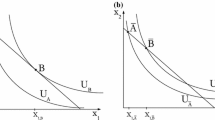Summary
Short-term Foreign Trade Estimates for the Federal Republic of Germany. — In the econometric estimates of Germany’s foreign trade at least one of the cyclical variables, i.e. capacity utilization rate, accelerator and judgement of inventory levels, significantly enters each import equation and — with one exception — each export equation. However, as opposed to the results of other empirical investigations, the dominating influence of the capacity utilization rate could not be substantiated. The long-term influences on import demand are captured by disposable income as well as those final demand components with a high import content. The long-term development of exports can be explained by production in the respective countries. The size of the estimated import price elasticities corresponds quite well with a priori expectations : the lowest elasticity was exhibited by products for which domestic substitutes exist only to a limited degree. On the other hand, imports of price-competitive consumer goods revealed the highest elasticity. The price elasticity of demand for total imports was calculated to be -0.50. With respect to export demand, the equations — disaggregated by countries — produced significant results for the price variables in almost all cases. For total exports to OECD countries the export price elasticity amounted to -1.09. Given this estimate as well as the above mentioned import price elasticity it can be generally concluded that the requirements of the Marshall-Lerner condition are met.
Résumé
L’estimation de court terme du commerce extérieur de la République Fédérale d’Allemagne. — Dans l’estimation économétrique du commerce extérieur allemand des variables cycliques — l’utilisation de l’équipement, l’accélérateur et l’opinion des entreprises sur les stocks — jouent un rÔle important. Pourtant, l’influence eminente de l’utilisation de l’équipement dans d’autres investigations empiriques du commerce extérieur ne pouvait pas Être supportée ici. Les influences de long terme sur la demande importatrice sont reflétées dans le revenu disponible et dans ceux composantes de la demande finale qui absorbent beaucoup de biens importés. L’évolution de long terme des exportations peut Être expliquée par la production dans les pays importatrices. Les coefficients estimés des variables de prix reflètent les caractéristiques économiques des groupes des biens importatrices individuels très bien. L’élasticité-prix des importations allemandes totales se chiffre á -0.50. Dans presque tous les cas, il y avait une influence de prix dans les équations des exportations désagrégées par des pays consommatrices. L’élasticité des exportations allemandes totales vers les pays OCDE se chiffre á -1.09. L’élasticité-prix des importations et des exportations permettent la conclusion que la condition de Marshall-Lerner est satisfaite.
Resumen
Funciones de estimación de corto plazo para el comercio de la Repüblica Federal de Alemania. — En la estimación econométrica del comercio exterior alemán las variables cíclicas de utilización de capacidad instalada, acelerador y apreciación de stock, juegan un papel importante. La influencia más que proporcional de la utilización de la capacidad instalada en otras investigaciones empiricas del comercio exterior no pudo ser confirmada aquf. Las influencias de más largo plazo sobre la demanda por importaciones se reflejan a través del ingreso disponible y de aquellos componentes de la demanda final a los que se incorporan los bienes importados. El desarrollo de largo plazo de las exportaciones se puedo explicar por la producción del pais importador en cuestiÔn. Los coeficientes estimados de las variables de precios, reflejan muy bien las caracteristicas econÔmicas de los grupos de productos de importación individuales. La elasticidad-precio para todos los productos de importación alemanes es de -0,50. Entre las funciones de exportación desagregadas por paises de destino, se déterminé en casi todos los casos un efecto-precio. La elasticidad-precio del total de las exportaciones alemanas hacia los paises de la OCDE se calculé en -1,09. Junto con la elasticidad-precio de las importaciones, se concluye, que se cnmple la condition Marshall-Lerner.
Similar content being viewed by others
Literatur
Akhtar, M. A., «Manufacturing Import Functions for the United Kingdom, West Germany and France». Economia Internazionale, Vol. 32, Genova 1979, S. 181–199.
Barker, T. S., «Aggregation Error and Estimates of the U.K. Import Demand Function». In: Kenneth Hilton and David F. Heathfield (Eds.), The Econometric Study of the United Kingdom. London 1970, S. 115–143.
Evans, Michael K., Macroeconomic Activity. Theory, Forecasting, and Control. An Econometric Approach. Forew. by L.R.Klein. New York 1969.
Giersch, Herbert, «Akzelerationsprinzip und Importneigung». Weltwirtschaftliches Archiv, Vol. 70, 19531, S. 241–283.
Gregory, R. G., «United States Imports and Internal Pressure of Demand, 1948-68». The American Economic Review, Vol. 61, Evanston 1971, S. 28–47.
Helmschrott,Helmut, Die Lagerbeurteilung als Konjunkturindikator. Ifo-Institut für Wirtschaftsforschung, CIRET-Studien, Nr. 1, München 1963.
Junz, Helen B., Rudolf R. Rhomberg, «Price Competitiveness in Export Trade among Industrial Countries». The American Economic Review, Vol. 63, Menasha 1973, Papers and Proceedings, S. 412–418.
Learner,Edward E., andRobert M. Stern, Quantitative International Economics. Boston 1970.
Magee, Stephen P., «Prices, Incomes, and Foreign Trade». In: Peter B. Kenen (Ed.), International Trade and Finance: Frontiers for Research. Cambridge 1975, S. 175–252.
Orcutt, Guy H., «Measurement of Price Elasticities in International Trade». The Review of Economics and Statistics, Vol. 32, Cambridge, Mass., 1950, S. 117–132.
Sandermann,Günter, Die Zahlungsbilanz der Bundesrepublik Deutschland 1960 bis 1970: Eine theoretische und ökonometrische Studie. Meisenheim am Glan 1975.
Statistisches Bundesamt (Wiesbaden), Fachserie 3: Land- und Forstwirtschaft, Reihe 3 : Pflanzliche Erzeugung. Stuttgart, versch. Jgg.
-, Fachserie 7 : AuΒenhandel, Reihe 1 : Zusammenfassende übersichten für den AuΒenhandel. Stuttgart, versch. Jgg.
-, Fachserie 17: Preise, Reihe 8: Preise und Preisindizes für die Ein- und Ausfuhr. Stuttgart, versch. Jgg.
Westphal,Uwe, A Disaggregated Analysis of German Merchandise Imports. SYSIFO Research Memorandum, No. 7, University of Frankfurt, University of Hamburg, o. O. 1976.
Whitley, J. D., «Imports of Finished Manufactures: The Effects of Prices, Demand and Capacity». The Manchester School of Economic and Social Studies, Vol. 47, Manchester 1979, S. 325–348.
About this article
Cite this article
Naggl, W. Kurzfristige schÄtzfunktionen für den warenhandel der bundesrepublik deutschland. Weltwirtschaftliches Archiv 117, 687–705 (1981). https://doi.org/10.1007/BF02708118
Issue Date:
DOI: https://doi.org/10.1007/BF02708118




